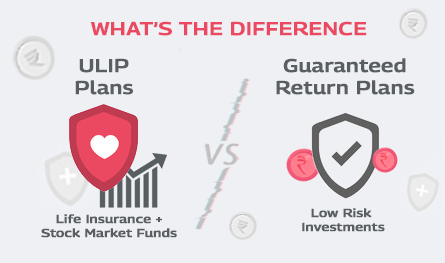ULIP Plans vs Guaranteed Return Plans: What’s the Difference?

When it comes to financial planning, people often want to choose the best of both worlds: returns and security. If you have been looking for these two elements under one plan, then you would have come across ULIPs and Guaranteed Return Plans. While ULIP plans offer high returns, guaranteed return plans ensure stability and security. Which one is the most suitable for you? That's a topic worth discussing.

Features of ULIP Plans
Unit Linked Insurance Policies or ULIP plans are life insurance plans that let you invest a part of your premium in the stock market funds. Its features are:
- A part of the premium provides you with life insurance coverage, while the other part goes to market-linked investments
- You may choose to invest in debt, equity, or hybrid funds
- Fund managers manage these funds
- Depending on the changes in your needs/ the market, you may choose to switch funds and rebalance your portfolio.
- While ULIPs offer dual benefits, they also have a 5-year lock-in period.
- Due to stock market exposure, the risks can be high compared to guaranteed return plans.
Features of Guaranteed Return Plans
Guaranteed return plans refer to various types of policies that offer life insurance coverage along with savings elements. Check out their features:
- Unlike ULIP plans, these plans do not expose your premium to stock market funds. Rather, a part of the premium goes towards secure and low-risk investments
- The life assured gets life insurance coverage until the chosen policy tenure
- Upon maturity of the policy, the assured receives maturity benefit in the form of regular or lump-sum payout
- Guaranteed return plans may also have a lock-in period.
ULIP Plans vs Guaranteed Return Plans: What’s the Difference?
Whether you choose to purchase ULIP plans or guaranteed return plans, certain risks are associated with each one. So, before you make a decision, it is important that you go through each plan option carefully:
| ULIPs | Guaranteed return plans |
| Ulips invest a part of your premium in money-linked instruments. Exposure to the stock market increases the risk | Guaranteed return plans invest in low-risk investments and so the risks, as well as the returns, may be low |
| As ULIPs are exposed, they offer the potential for high returns. This can make them a suitable option for long-term wealth creation | Over time, these policies may not be able to beat inflation so, they don't end up growing your wealth |
| ULIPs include certain charges like premium allocation charges, fund management charges, etc. | While there are charges in guaranteed return plans, they are typically lower |
| ULIPs offer you the freedom to switch between funds in order to match your changing needs or market conditions | When it comes to flexibility during the policy term, guaranteed return plans are quite fixed. |
| ULIPs usually come with a lock-in period of 5 years, during which you may not withdraw any amount. | The lock-in period limits your financial flexibility for the initial years. You may be allowed to surrender your plan under some conditions |
Which is Better: ULIPs or Guaranteed Return Plans?
So, now that you are aware of the benefits and risks of ULIP plans and guaranteed return plans, which one do you find more suitable? You may consider these factors to choose one among these:
1. High returns Vs stability
You need to assess your return expectations. If you want high returns, ULIPs can be your choice. However, if you prioritise financial security and you're ok with low returns, guaranteed return plans can be the right choice.
2. Risk tolerance
Your risk tolerance level may directly impact your choice. ULIPs are riskier than guaranteed return plans since the former actively invests in the stock market. However, if your risk appetite is low, you may go with guaranteed return plans.
3. Investment horizon
Both ULIP plans and guaranteed return plans have a long-term investment horizon of at least over 5 years. So, you need to decide a policy accordingly.
4. Financial goals
Your financial goals are the primary factor that you need to consider. Depending on what you are saving for, you need to analyse if stable returns may be the right choice or if you need a more flexible option like a ULIP plan.

Author Bio
Paybima Team
Paybima is an Indian insurance aggregator on a mission to make insurance simple for people. Paybima is the Digital arm of the already established and trusted Mahindra Insurance Brokers Ltd., a reputed name in the insurance broking industry with 17 years of experience. Paybima promises you the easy-to-access online platform to buy insurance policies, and also extend their unrelented assistance with all your policy related queries and services.
Other Life Insurance Products
Latest Post
.png)
When you sign up for a life insurance policy - whether it’s a traditional term insurance policy or a ULIP – you are not just buying peace of mind. You are also trusting the insurer with your money. So naturally, you would want to know: How is that money being managed? And more importantly, how is it being protected from risky decisions?


Have you ever caught yourself lost in illusions about your daughter's future events, such as her university convocation and first day at work? Her university convocation. When she embarks upon her initial job after graduation will be the day.


Term insurance is an important investment. However, with the availability of so many insurers offering term plans, it becomes difficult to select the best term plan to suit your needs. Buying a term plan needs some consideration and research on the part of the policyholder. In this post, let us discuss the best term insurance providers in India.

In a country where medical inflation is rising rapidly, securing a comprehensive health coverage plan for the entire family is no longer optional, it is essential. Selecting the right health insurance requires careful evaluation of multiple factors, not just premium costs. A well-chosen plan ensures financial security, access to quality healthcare, and peace of mind during medical emergencies.




.png)
